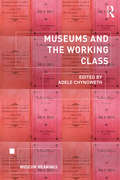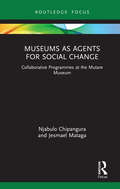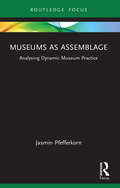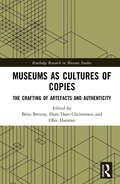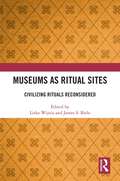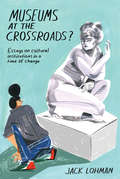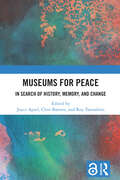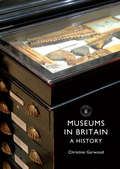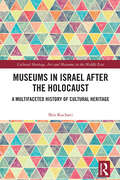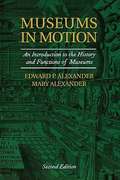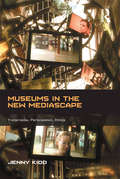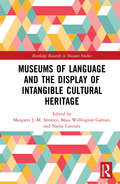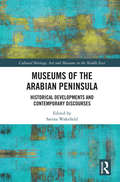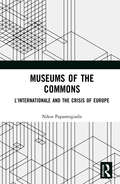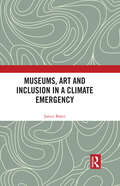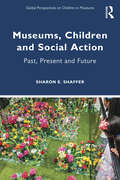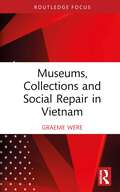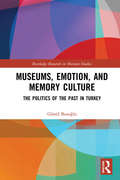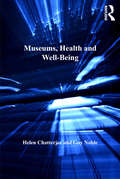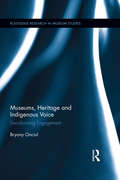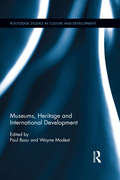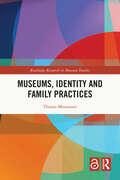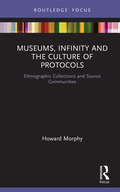- Table View
- List View
Museums and the Working Class (Museum Meanings)
by Adele ChynowethMuseums and the Working Class is the first book to take an intersectional and international approach to the issues of economic diversity and class within the field of museum studies. Bringing together 16 contributors from eight countries, this book has emerged from the significant global dialogue concerning museums’ obligation to be inclusive, participate in meaningful engagement and advocate for social change. As part of the push for museums to be more accessible and inclusive, museums have been challenged to critically examine their power relationships and how these are played out in what they collect, whose stories they exhibit and who is made to feel welcome in their halls. This volume will further this professional and academic debate through the discussion of class. Contributions to the book will also reinforce the importance of the working class – not only in collection and exhibition policy, but also for the organisational psychology of institutions. Museums and the Working Class is essential reading for scholars and students of museum, gallery and heritage studies, cultural studies, sociology, labour studies and history. It will also serve as a source of honest and research-led inspiration to practitioners working in museums, galleries, libraries, archives and at heritage sites around the world.
Museums as Agents for Social Change: Collaborative Programmes at the Mutare Museum (Museums in Focus)
by Njabulo Chipangura Jesmael MatagaMuseums as Agents for Social Change is the first comprehensive text to examine museum practice in a decolonised moment, moving beyond known roles of object collection and presentation. Drawing on studies of Mutare museum, a regional museum in Eastern Zimbabwe, this book considers how museums with inherited colonial legacies are dealing with their new environments. The book provides an examination of Mutare museum’s activism in engaging with topical issues affecting its surrounding community and Chipangura and Mataga demonstrate how new forms of engagement are being deployed to attract new audiences, whilst dealing with issues such as economic livelihoods, poverty, displacement, climate change and education. Illustrating how recent programmes have helped to reposition Mutare museum as a decolonial agent of social change and an important community anchor institution, the book also demonstrates how other museums can move beyond the colonial preoccupation with the gathering of collections, conservation and presentation of cultural heritage to the public. Museums as Agents for Social Change will primarily be of interest to academics and students working in the fields of museum and heritage studies, history, archaeology and anthropology. It should also be appealing to museum professionals around the world who are interested in learning more about how to decolonise their museum.
Museums as Assemblage: Analysing dynamic museum practice (Museums in Focus)
by Jasmin PfefferkornMuseums as Assemblage offers a new way of thinking about the dynamism of art museums. Using the concept of assemblage, this book unpacks relations between visitors, artists, museum staff, and the museum’s nonhuman components, providing an analytical framework that celebrates the complexity of museums today. It takes the Museum of Old and New Art (Mona) in Tasmania as its primary case study but situates it in global trends by drawing on a range of examples from art museums across Australia, New Zealand, Europe, and East Asia. It provides insight into how perceptions around engagement are enabled and constrained in the context of different museums and highlights the necessity of an analytical framework that accommodates the complexity and multiplicity of the contemporary museum landscape. With an emphasis on visitor experience and curatorial strategy, the book is valuable for students and researchers in museum studies, art history, curatorial studies, and cultural studies.
Museums as Cultures of Copies: The Crafting of Artefacts and Authenticity (Routledge Research in Museum Studies)
by Brita Brenna Hans Dam Christensen Olav HamranFew institutions are warier of copies than museums. Few fields of knowledge are more prone to denounce copies as fake than the heritage field. Few discourses are as concerned with authenticity, aura, originals and provenance as those concerning exhibiting and collecting. So why is it that these are institutions, fields and discourses where copies proliferate and copying techniques have thrived for hundreds of years? Museums as Cultures of Copies aims to make the copying practices of museums visible and to discuss, from a range of interrelated perspectives, precisely what function copies fulfil in the heritage field and in museums today. With contributions from Europe and Canada, the book interrogates the meaning of copies and presents copying as a fully integrated part of museum work. Including chapters on ethnographic mannequins, digitalized photos, death masks, museum documentation and mechanical models, contributors consider how copying as a cultural form changes according to time and place and how new forms of copying and copy technologies challenge and expand museum work today. Arguing that copying is at the basis of museum practice and that new technologies and practices have been taken up and developed in museums since their inception, the book presents both heritage work and copies in a new light. Museums as Cultures of Copies should be of great interest to academics, scholars and postgraduate students working in the fields of museum and heritage studies, as well as visual studies, cultural history and archaeology. It should also be essential reading for museum practitioners.
Museums as Ritual Sites: Civilizing Rituals Reconsidered
by James S. Bielo Lieke WijniaMuseums as Ritual Sites critically examines the assumption that museums inherently function as ritual sites and, in turn, are poised to exert influence on cultural and societal change.Bringing together a diverse, international group of interdisciplinary scholars and curators, the volume celebrates and critically engages with Carol Duncan’s seminal work, Civilizing Rituals. Presenting a wide-ranging exploration of how museums function as liminal zones in broader societal contexts, the book discusses major topics identified as functioning at the heart of the above-mentioned paradigm shift: diversity and inclusion, consumption, religion, and tradition. These topics are studied through the lens of their ritual implications in museum practice. Presenting case studies on ethnographic, art, history, community, and memorial practices in museums, the book reflects the diversity of the contemporary international museum field. As such, the volume presents a critical and updated revision of the ritual perspective on museums - both as it was presented by Duncan and as it has since been developed in the field of museum studies.Museums as Ritual Sites will be essential reading for academics and students working in museum studies, heritage studies, cultural anthropology, religious studies, and ritual studies. Museums as Ritual Sites will also be of interest to those working across the humanities and social sciences who are interested in the intersection of museums or archives with indigeneity and decolonization.
Museums at the Crossroads?: Essays on Cultural Institutions in a Time of Change
by Jack LohmanIn this collection of illuminating essays, Jack Lohman, chief executive officer of the Royal British Columbia Museum, shares his views on the role of museums in the various cultures of the world, on the importance of architecture and design in the personality of a museum, on the challenges of creating resilient cultural institutions in the face of financial crises, and much more. He speaks from the heart and from his many years of experience in some of the great museums, in London, Rio de Janeiro, Cape Town, Warsaw and many other cities around the world.
Museums for Peace: In Search of History, Memory, and Change
by Joyce Apsel Clive Barrett Roy TamashiroMuseums for Peace: In Search of History, Memory and Change highlights the inspiring as well as conflicting representations and purposes of diverse museums for peace around the world. Coming from various cultural and professional backgrounds, the authors explore “what are museums for peace and what do they mean?” Some chapters introduce alternative histories of peace, conflict, and memorialization. This innovative collection examines grassroots museums, military sexual slavery, historical memory in East Asia, and cultural heritage in the Africanized peace museum movement. The chapters discuss differing representations of Gandhi, technology of war and opposition to it, and structural violence such as racial terror and imperialism. Investigating how institutions interact with political and cultural forces, the volume demonstrates that some museums reinforce hegemonic narratives, while others resist authoritative tropes to reveal silenced histories, including peace histories. Museums for Peace will appeal to academics and students in museum studies, heritage studies, peace studies, memory studies, social justice, and human rights. Those working in cultural studies and trauma studies will also find this volume valuable.
Museums for Peace: In Search of History, Memory, and Change
by Joyce Apsel Clive Barrett Roy TamashiroMuseums for Peace: In Search of History, Memory and Change highlights the inspiring as well as conflicting representations and purposes of diverse museums for peace around the world.Coming from various cultural and professional backgrounds, the authors explore “what are museums for peace and what do they mean?” Some chapters introduce alternative histories of peace, conflict, and memorialization. This innovative collection examines grassroots museums, military sexual slavery, historical memory in East Asia, and cultural heritage in the Africanized peace museum movement. The chapters discuss differing representations of Gandhi, technology of war and opposition to it, and structural violence such as racial terror and imperialism. Investigating how institutions interact with political and cultural forces, the volume demonstrates that some museums reinforce hegemonic narratives, while others resist authoritative tropes to reveal silenced histories, including peace histories.Museums for Peace will appeal to academics and students in museum studies, heritage studies, peace studies, memory studies, social justice, and human rights. Those working in cultural studies and trauma studies will also find this volume valuable.The Open Access version of this book, available at http://www.taylorfrancis.com, has been made available under a Creative Commons Attribution-Non Commercial-No Derivatives (CC-BY-NC-ND)] 4.0 license.
Museums in Britain
by Christine GarwoodMuseums are at the heart of the nation's cultural life, bastions of Britishness in almost every major city and town. Together they detail myriad aspects of our heritage: from lawnmowers to cuckoo clocks, pencils to chairs, there seems to be no end to the subject matter deemed worthy of collection and public display. This overview of museums in Britain traces their development from 'cabinets of curiosity' to large scale visitor attractions, taking in broad social shifts and trends as well as the collectors, eccentrics and visionaries and the legacies they have left.
Museums in Israel after the Holocaust: A Multifaceted History of Cultural Heritage (Cultural Heritage, Art and Museums in the Middle East)
by Shir Gal KochaviMuseums in Israel After the Holocaust explores the influence of the traumatic events of the Holocaust on the formation of a cultural heritage policy during the foundational years of the State of Israel.Based on primary research, the book offers a new understanding of cultural practices after the Second World War, while analyzing the role of key Jewish cultural representatives who shaped museum collections that emerged during this period. The book investigates the ways Israel has dealt with the complicated history of “heirless” Jewish cultural objects and questions of ownership, by providing a detailed examination of the process of allocation of “heirless” Jewish cultural property handled by two American-Jewish organizations: the Jewish Restitution Successor Organization (JRSO) and the Jewish Cultural Reconstruction (JCR) in the immediate years following the Second World War. The book takes a material culture approach, which explores the meanings and values attached to an object over the course of time and during its transition between different owners.Museums in Israel After the Holocaust is essential reading for academics, students, and professionals working on and interested in Holocaust and Israel studies, art history, material culture studies, museum studies, cultural heritage, and Middle Eastern studies.
Museums in Motion: An Introduction to the History and Functions of Museums (Second Edition)
by Edward P. Alexander Mary AlexanderThis book presents the history of museums since the eighteenth century with a detailed examination of the function of museums and museum workers in modern society.
Museums in the New Mediascape: Transmedia, Participation, Ethics (Digital Research in the Arts and Humanities)
by Jenny KiddThe museum today faces complex questions of definition, representation, ethics, aspiration and economic survival. Alongside this we see burgeoning use of an array of new media including increasingly dynamic web portals and content, digital archives, social networks, blogs and online games. At the heart of this are changes to the idea of ’visitor’ and ’audience’ and their participation and representation in the new cultural sphere. This insightful book unpacks a number of contradictions that help to frame and articulate digital media work in the museum and questions what constitutes authentic participation. Based on original empirical research and a range of case studies the author explores questions about the museum as media from a number of different disciplines and shows that across museums and the study of them, the cultural logic is changing.
Museums of Language and the Display of Intangible Cultural Heritage (Routledge Research in Museum Studies)
by Maia Wellington Gahtan Margaret J.-M. Sönmez Nadia CannataMuseums of Language and the Display of Intangible Cultural Heritage presents essays by practitioners based in language museums around the world. Describing their history, mission, and modes of display, contributors demonstrate the important role intangible heritage can and should play in the museum. Arguing that languages are among our most precious forms of cultural heritage, the book also demonstrates that they are at risk of neglect, and of endangerment from globalisation and linguistic imperialism. Including case studies from across Europe, North America, Africa, and Asia, this book documents the vital work being done by museums to help preserve languages and make them objects of broad public interest. Divided into three sections, contributions to the book focus on one of three types of museums: museums of individual languages, museums of language groups – both geographic and structural – and museums of writing. The volume presents practical information alongside theoretical discussions and state-of-the-art commentaries concerning the representation of languages and their cultural nature. Museums of Language and the Display of Intangible Cultural Heritage is the first volume to address the subject of language museums and, as such, should be of interest to academics, researchers, and postgraduate students in the fields of museum and cultural heritage studies, applied linguistics, anthropology, tourism, and public education.
Museums of the Arabian Peninsula: Historical Developments and Contemporary Discourses (Cultural Heritage, Art and Museums in the Middle East)
by Sarina WakefieldMuseums of the Arabian Peninsula offers new insights into the history and development of museums within the region. Recognising and engaging with varied approaches to museum development and practice, the book offers in-depth critical analyses from a range of viewpoints and disciplines. Drawing on regional and international scholarship, the book provides a critical and detailed analysis of museum and heritage institutions in Bahrain, Jordan, Kuwait, Oman, Qatar, Saudi Arabia, the UAE and Yemen. Questioning and engaging with issues related to the institutionalisation of cultural heritage, contributors provide original analyses of current practice and challenges within the region. Considering how these challenges connect to broader issues within the international context, the book offers the opportunity to examine how museums are actively produced and consumed from both the inside and the outside. This critical analysis also enables debates to emerge that question the appropriateness of existing models and methods and provide suggestions for future research and practice. Museums of the Arabian Peninsula offers fresh perspectives that reveal how Gulf museums operate from local, regional and transnational perspectives. The volume will be a key reference point for academics and students working in the fields of museum and heritage studies, anthropology, cultural studies, history, politics and Gulf and Middle East Studies.
Museums of the Commons: L’Internationale and the Crisis of Europe
by Nikos PapastergiadisMuseums of the Commons examines L’Internationale, an ongoing confederation between six museums and contemporary art institutions in Europe. Drawing on extensive interviews with the directors, curators, public programs officers in all the museums, as well as artists, critics and members associated with them, the book provides a transversal account that connects the ideas across the various institutions and situates this in the wider visual and social context. Chronicling the challenges faced by the museums, Papastergiadis goes on to situate their responses within the wider political and cultural context that is shaping the future of all contemporary art museums. Five key domains of research are explored within the book: the genealogy of the museum; the need for alternative models of trans-institutional governance; examples of innovation in the spaces of aesthetic production; experimentation in the forms of partnership and engagement with constituents; and finally, examination of the impact of a collaborative and collective regime of artistic practices. Museums of the Commons provides a multi-perspectival account of a trans-institutional and transnational collaboration, which will be of great interest to academics, researchers and postgraduate students working in the fields of Museum Studies, Cultural Studies, Art History, Media and Communication.
Museums, Art and Inclusion in a Climate Emergency
by Janice BakerMuseums, Art and Inclusion in a Climate Emergency considers the impact of the Anthropocene on history and memory, approaches to objects and agency and the incommensurability of western and Indigenous ontologies. Drawing on Indigenous knowledge, humanities and museological literature, continental philosophy, contemporary art and popular culture, Baker acknowledges the autonomous agency of geological forms, including soils, minerals and fossil fuels. Demonstrating that this has implications for an expanded idea of an ‘inclusive’ museum and its relationship to entities beyond ‘life’ and living species, the book argues that the ‘inclusion’ paradigm needs to include nonlife actors. Gesturing to a geontological ‘turn’ through developing notions of geo-inclusion, the mineralhuman and approaches to object agency that connect with Aboriginal ‘heritage’, Baker exposes the ongoing destruction of Country by mining interests in Western Australia and elsewhere. By addressing the need for urgent change through the artifice of the museum, the book identifies an expanded approach to inclusion beyond the limits imposed by the politics of identity. Museums, Art and Inclusion in a Climate Emergency theorises the potential of an expanded idea of the museum and will be of interest to scholars and students engaged in the study of museums and heritage, environmental humanities and geo-humanities, ecological art history and contemporary art.
Museums, Children and Social Action: Past, Present and Future (Global Perspectives on Children in Museums)
by Sharon E. ShafferMuseums, Children and Social Action examines the role that museums play in reaching, teaching and inspiring children as global citizens of the world and, looking to the future, argues that the sustainability of museums will come from strengthening relationships with young visitors. Presenting a diverse range of programs, exhibitions and outreach from museums across five continents, Shaffer highlights how museums are already serving children and making a difference in their lives. Arguing that museums have a unique responsibility to connect this audience with relevant social issues and challenges, such as social injustice, racism, climate change and poverty, Shaffer simultaneously acknowledges that a large number of children are still on the margins of the institution and its mission. Recognizing the ways in which museums are currently serving children, the book also considers what museums could and should be doing as they plan for the future, raising critical questions about core values, community partners and social agendas. Museums, Children and Social Action is essential reading for academics and students engaged in the study of museums, social justice and childhood. It encourages museums to make it their mission to educate and serve this audience and their families for the good of children, as well as museums, while also considering what their institutions can do to make a lasting impact on children and their families.
Museums, Collections and Social Repair in Vietnam (Routledge Research on Museums and Heritage in Asia)
by Graeme WereMuseums, Collections and Social Repair in Vietnam analyses the relationship between museums, collections and social repair in contemporary Vietnam. Drawing on fieldwork in a range of museums in the country, alongside interviews with museum workers and stakeholders, and analyses of museum exhibitions, the book explores how museums help ordinary people overcome loss suffered during conflict. Focusing on key objects in museum collections that elicit strong emotions or feelings, Graeme Were examines their relationship to social repair and transformation, in order to understand what mobilises survivors, families and communities to recover and re-evaluate memory and give prominence to grievances and loss or future hopes and aspirations. Arguing that nationalist frameworks no longer adequately account for the diverse agendas of Vietnamese museums, this book brings into question the dynamics between history and memory; the capacity of the museum to repair injury, loss or suffering; and the limits of historical memory beyond the control of a one-party state. Museums, Collections and Social Repair in Vietnam analyses the role of museums in transforming lives and creating a just future. It will be of interest to academics and students engaged in the study of museums, heritage, Asia, tourism and anthropology.
Museums, Emotion, and Memory Culture: The Politics of the Past in Turkey (Routledge Research in Museum Studies)
by Gönül BozoğluMuseums, Emotion, and Memory Culture examines the politics of emotion in history museums, combining approaches and concerns from museum, heritage and memory studies, anthropology and studies of emotion. Exploring the meanings and politics of memory contests in Turkey, a site for complex negotiations of identity, the book asks what it means for museums to charge the past with political agendas through spectacular, emotive representations. Providing an in-depth examination of emotional practice in two Turkish museums that present contrasting representations of the national past, the book analyses relationships between memory, governmentality, identity, and emotion. The museums discussed celebrate Ottoman and Early Republican pasts, linking to geo- and party politics, people’s senses of who they are, popular memory culture, and competing national stories and identities vis-à-vis Europe and the wider world. Both museums use dramatic, emotive panoramas as key displays and the research at the heart of this book explores this seemingly anachronistic choice, and how it links with memory cultures to prompt visitors to engage imaginatively, socially, politically and morally with a particular version of the past. Although the book focuses on museums in Turkey, it uses this as a platform to address broader questions about memory culture, emotion, and identity. As such, Museums and Memory Culture should be of great interest to academics and students around the world who are engaged in the study of museums, heritage, culture, history, politics, anthropology, sociology, and the psychology of emotion.
Museums, Health and Well-Being
by Helen Chatterjee Guy NobleThe role of museums in enhancing well-being and improving health through social intervention is one of the foremost topics of importance in the museums sector today. With an aging population and emerging policies on the social responsibilities of museums, the sector is facing an unprecedented challenge in how to develop services to meet the needs of its communities in a more holistic and inclusive way. This book sets the scene for the future of museums where the health and well-being of communities is top of the agenda. The authors draw together existing research and best practice in the area of museum interventions in health and social care and offer a detailed overview of the multifarious outcomes of such interactions, including benefits and challenges. This timely book will be essential reading for museum professionals, particularly those involved in access and education, students of museums and heritage studies, as well as practitioners of arts in health, art therapists, care and community workers.
Museums, Heritage and Indigenous Voice: Decolonizing Engagement (Routledge Research in Museum Studies #10)
by Bryony OnciulCurrent discourse on Indigenous engagement in museum studies is often dominated by curatorial and academic perspectives, in which community voice, viewpoints, and reflections on their collaborations can be under-represented. This book provides a unique look at Indigenous perspectives on museum community engagement and the process of self-representation, specifically how the First Nations Elders of the Blackfoot Confederacy have worked with museums and heritage sites in Alberta, Canada, to represent their own culture and history. Situated in a post-colonial context, the case-study sites are places of contention, a politicized environment that highlights commonly hidden issues and naturalized inequalities built into current approaches to community engagement. Data from participant observation, archives, and in-depth interviewing with participants brings Blackfoot community voice into the text and provides an alternative understanding of self and cross-cultural representation. Focusing on the experiences of museum professionals and Blackfoot Elders who have worked with a number of museums and heritage sites, Indigenous Voices in Cultural Institutions unpicks the power and politics of engagement on a micro level and how it can be applied more broadly, by exposing the limits and challenges of cross-cultural engagement and community self-representation. The result is a volume that provides readers with an in-depth understanding of the nuances of self-representation and decolonization.
Museums, Heritage and International Development (Routledge Studies in Culture and Development #1)
by Wayne Modest Paul BasuWhile many claims are made regarding the power of cultural heritage as a driver and enabler of sustainable development, the relationship between museums, heritage and development has received little academic scrutiny. This book stages a critical conversation between the interdisciplinary fields of museum studies, heritage studies and development studies to explore this under-researched sphere of development intervention. In an agenda-setting introduction, the editors explore the seemingly oppositional temporalities and values represented by these "past-making" and "future-making" projects, arguing that these provide a framework for mutual critique. Contributors to the volume bring insights from a wide range of academic and practitioner perspectives on a series of international case studies, which each raise challenging questions that reach beyond merely cultural concerns and fully engage with both the legacies of colonial power inequalities and the shifting geopolitical dynamics of contemporary international relations. Cultural heritage embodies different values and can be instrumentalized to serve different economic, social and political objectives within development contexts, but the past is also intrinsic to the present and is foundational to people’s aspirations for the future. Museums, Heritage and International Development explores the problematics as well as potentials, the politics as well as possibilities, in this fascinating nexus.
Museums, Identity and Family Practices (Routledge Research in Museum Studies)
by Theano MoussouriMuseums, Identity and Family Practices locates museum participation and meaning making in the realm of everyday family practices, which are central to understanding the role museums play in family social life.Drawing on a substantial amount of data from a wide range of sources, Moussouri discusses the importance of understanding how family practices are enacted across settings and how the arena of the museum can facilitate certain family practices and impede others. Developing and theorising key concepts, the book elucidates the key research themes, including everyday family practice; meaning making; and the structural characteristics of museums as arenas for the family visit activity. The analysis is rooted in a dialectical theoretical framework specifically developed to bridge the macrolevel (social order or the arena of the museum) and microlevel (family practices).Museums, Identity and Family Practices offers a novel and holistic approach to studying contemporary families and, as such, is key reading for scholars and students of museum and heritage studies, family studies, visitor studies, cultural studies, education, sociology and anthropology. Museum and heritage professionals working with families in different communities around the world will also find this book relevant to their practice.The Open Access version of this book, available at http://www.taylorfrancis.com, has been made available under a Creative Commons Attribution-Non Commercial-No Derivatives (CC-BY-NC-ND) 4.0 license.
Museums, Infinity and the Culture of Protocols: Ethnographic Collections and Source Communities (Museums in Focus)
by Howard MorphyMuseums, Infinity and the Culture of Protocols enters a dialogue about museums’ responsibility for the curation of their collections into an infinite future while also tackling contentious issues of repatriation and digital access to collections. Bringing into focus a number of key debates centred on ethnographic collections and their relationship with source communities, Morphy considers the value material objects have to different ‘local’ communities – the museum and the source community – and the value-creation processes with which they are entangled. The focus on values and value brings the issue of repatriation and access into a dialogue between the two locals, questioning who has access to collections and whose values are taken into consideration. Placing the museum itself firmly at the centre of the debate, Morphy posits that museums constitute a kind of ‘local’ embedded in a trajectory of value. Museums, Infinity and the Culture of Protocols challenges aspects of postcolonial theory that position museums in the past by presenting an argument that places relationships with communities as central to the future of museums. This makes the book essential reading for academics and students working in the fields of museum and heritage studies, anthropology, archaeology, Indigenous studies, cultural studies, and history.
Museums, International Exhibitions and China's Cultural Diplomacy (Routledge Research in Museum Studies)
by Da KongMuseums, International Exhibitions and China’s Cultural Diplomacy examines the role museums and, more specifically, international exhibitions, have played in shaping China’s international image to date. Drawing on theories and methods from museum studies and international relations, the book evaluates the contribution international exhibitions make to China’s cultural diplomacy strategy. Considering their impact on the country’s international image, Kong also probes the mechanisms and processes involved, examining in detail the policy of, and international activities promoted by, the Chinese government. The book also analyses the motives of the Chinese and overseas museums that host these exhibitions. Taking some major exhibitions that were on show in the UK during the 21st century as a representative case study, the book reveals the mechanisms by which these exhibitions were developed and shared overseas. Questioning who really shapes the image of China, Kong challenges Western assumptions and looks ahead to consider whether, moving forward, the Chinese government and museums could work together in a mutually beneficial way. Museums, International Exhibitions and China’s Cultural Diplomacy contributes to the growing literature on museums and diplomacy. As such, it will be of interest to academics and students engaged in the study of museums and heritage, international relations, culture, politics, China and wider Asia.
